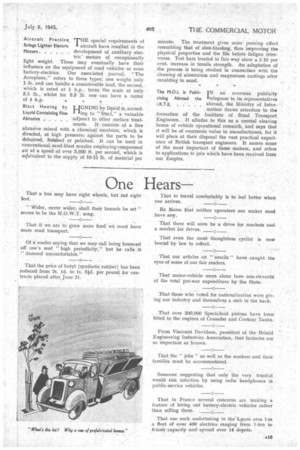Passing Comments
Page 14

Page 15

If you've noticed an error in this article please click here to report it so we can fix it.
AN interesting point brought out by Mr. J. S. Nicholl, C.B.E., of McNamara and Co., Ltd., during the joint meeting of eight bodies organized• by the I.A.E., and held on June 27, was that high speed does not necessarily mean that roads can accommodate more traffic. According to several authorities, the maximum flow is attained at speeds of between 128 and 25 m.p.h.; higher rates of travel mean greater spacing between vehicles, which more than offsets the increased velocity. This does not, of course, imply that a fast vehicle doe' not reach its destination more rapidly than a slow one—it is a question of the total flow which a particular traffic lane can accommodate,
Does High Speed Reduce Total Traffic Flow /
Does Driver's Position I T has been suggested that Affect Safety on drivers of private cars would Road? . . . . become even more careful in
avoiding collisions if they were nearer the possible point of contact—in other words, if, as in many coaches and buses, 'the driver were to be positioned right at the front and not have a long engine, radiator and other " buffer " parts in front of him. He would, incidentally, have a greatly improved view of the road. This forward control could be achieved by placing the driver's seat alongside the engine or putting the latter in some other position, such as at the rear. Some cars have, of course, been built in this way, but have not proved highly popular.
Aircraft Practice THE special requirements of Brings Lighter Electric I aircraft have resulted in the Motors development of auxiliary electric motors of exceptionally light weight. These may eventually have their influence on the equipment of road vehicles or even
battery-electrics. Our associated journal, ' The Aeroplane," refers to three types; one weighs only 1 lb. and can handle a considerable load, the second, which is rated at 1 h.p., turns the scale at only 3.5 lb., whilst for 8.3 lb. one can have a motor of 4 h.p.
Blast Honing by LIONING by liquid is, accordLiquid Containing Fine "ing to " Stec'," a valuable
Abrasive adjunct to other surface treat
ments. It consists of a fine abrasive mixed with a chemical emulsion, which is directed, at high pressure, against the par.ts to be deburred, finished or polished. It can be used in conventional sand-blast nozzles employing compressed air at a speed of over 3,000 ft. per second, which is eq4aivalent to the supply of 10-15 lb. of material per
minute. The treatment gives some peening effect resembling that of shot-blasting, thus improving the physical properties and the life before fatigue intervenes. Test bars treated in this way show a 5-10 per cent, increase in tensile strength. An adaptation of the process is being studied in connection with the cleaning of aluminium and magnesium castings after moulding in sand.
The M.0.1. Is PubliIN an overseas. publicity cizing Abroad the 'telegram to its representatives I.R.T.E. abroad, the Ministry of Infor mation draws attention to the formation of the Institute of Road Transport Engineers. It alludes :to this as a central clearing house of vehicle operational research, and says that it will be of enormous value to manufacturers, for it will place at their disposal the vast practical experience of British transport engineers. It names some of the most important of these makers, and refers to applications to join which have been received from our Empire.




















































